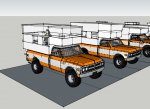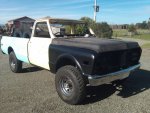Thanks for the responses.... yes I agree marine plywood might be overkill.... but I was thinking/wondering if it is a better/ stronger plywood one could go with thinner material and save some weight and still achieve the same strength. I was wondering if the thinner interior plies make it stronger
I plan to use baltic birch for the cabinetry but want larger sheets than 5x5 for some of the interior pieces...
I assume you are comparing baltic birch & okume marine ply to regular fir plywood - crappy CDX is definitely weaker but in any higher grade A/B, B/B the fir would be somewhat stronger than Okume ply & somewhat weaker that baltic birch - (this is based on the underlying strength of the wood species) but not enough to switch sizes however...Firs good stuff! Baltic is the heaviest & okume is the lightest.
Basically you go with marine or baltic birch for durability, looks & with okume - weight savings. The durability comes from no voids in the core & the weight savings come from how you use the stuff. The exposed bare edges of fir need a solid wood edging (for looks & splinters) and the rotary cut fir face veneers don't finish well at all - baltic & okumne don't have either problem. Because it finishes so nicely baltic & okume can be left clear or painted so they can be used both as structural & finishing members. Of course A faced fir ply can look ok too...as long as you deal with the edges - get it paper faced if you want to paint fir...
I wouldn't think twice about baltic birch in a wet environment - as long as it's epoxy sealed. My brother has a 21ft lapstrake skiff I built out of baltic birch 20 some years ago - no problems. I should of used okume however...
Check out Apple Ply - it's not apple...but's it's basically a North American sourced equivalent of baltic birch (that's my understanding anyway) the stuff I've used is noticeably lighter than the baltic birch I get...
http://www.appleply.com/pdfs/specsheets/ApplePly_SpecSheet.pdf
To use baltic or okume in the structural/finished surface dual role make sure the face plys are at
least 1.mm thick.
http://www.noahsmarine.com/United_States/Plywoods-us/plywoods-us.html
http://www.boulterplywood.com/MarinePlywood_4.htm
The sub-1mm face plys are a pain to finish/repair because you sand through them so quickly...Of course the good stuff is more expensive...For what it's worth baltic birch is heavy for cabinets...okume is lighter. I suggest you explore using cabinets/drawers out of thin ply bonded with epoxy fillets as in stitch & glue boat building. Food drawers out of 4mm-6mm ply are plenty strong using this technique - tool or book drawers might need up to 12mm but no way do you need the standard 3/4 -18mm sheet used in home cabinets - but you can't use mechanical fasteners into the the edge grain of the thin stuff so that's why you need the "liquid joinery" with epoxy & fillers. Interior cabinets/furniture built this way will be 1/4 to 1/2 the weight of conventional stuff & much stronger.
Are you looking for floor coverings or a structural floor solution? Moe


